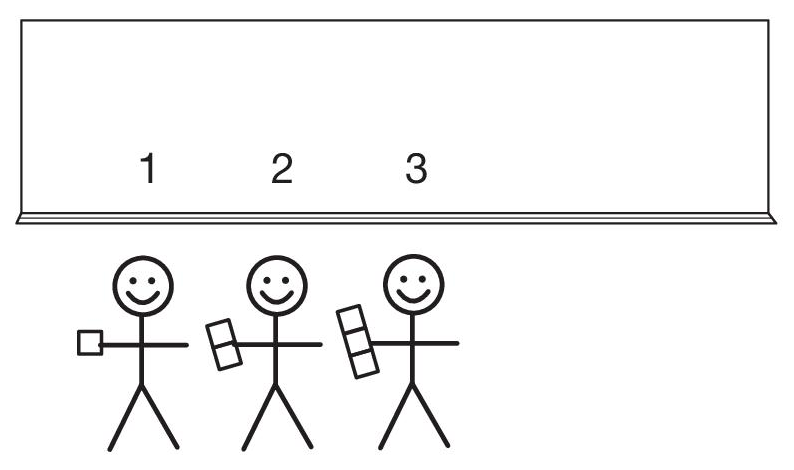Observe students during the Creating a Number Line
activity to assess their progress toward the following
Expectations:
- Count a collection of 0–20 objects [E1].
- Identify the quantity of a small collection of objects
without counting [E2].
- Count on from a given number [E4].
- Connect representations of quantities [E6].
While students are working, keep the following questions
in mind:
- Are students able to count the number of cubes in their
trains?
- Can students identify quantities of five cubes without
counting?
- Can students count their number of cubes using a
counting-on strategy?
- Can students make connections between the points on the
number line and the number of cubes?
Record your observations on the Unit 1 Assessment Record.
Distribute the trains of connecting cubes you prepared. See
Materials Preparation. Give them to stu-dents randomly so that
students sitting close to one another do not have a consecutive
number of cubes. Tell students that they are going to make a
number line.
Use the following prompts:
- How many cubes do you have in your train? Check
your answer with your neighbor.
- Who has one cube? Come to the front of the room
and stand in front of the board. I am going to write a 1 on
the board right above you.
- Who has two cubes? Stand next to [name of first
student]. I'm going to write a 2 on the board right above you
See Figure 2. Continue with the numbers 3 to 10 so that ten
students are standing in front of the room and the numbers 1 to
10 are written on the board in order from left to right. For a
few of the numbers greater than five, have students demonstrate
their counting strategies.
- How do you count your cubes?
- Show how to use a counting-on strategy.
With no cubes in your hands, stand to the left of the
student who is holding one cube.
- How many cubes do I have? (none, zero)
- What number should I write on the board that
represents the number of cubes I have? (0)
Write a 0 to the left of the 1 on the board and make hash
marks above each number. Connect the hash marks to complete the
number line to 10. See Figure 3. Continue with the number line by
repeating the procedure with the remaining students and their
trains of cubes. See Content Note. Occasionally, discuss the
students' methods for counting their trains, highlighting a
counting-on strategy

Number Lines. A number line
is a tool for representing numbers. Number lines extend
infinitely in both directions as shown by the arrows at each end
of the number line in
Figure 3. Since first-graders work
mainly with whole numbers into the hundreds, the number line
that they will use will begin at 0 and extend to 130. Students
should be aware that there are numbers to the left of zero
(negative numbers) and that the numbers continue past 130. The
whole numbers are equidistant from one another, so they are
evenly spaced on the number line. In first grade, students will
use number lines as tools for counting and computation,
particularly addition and subtraction. Later, students will use
the number line to represent larger whole numbers, fractions,
and negative numbers and continue to use it as a tool for
problem-solving.
Help students make connections between the representations
of the quantities.
- Why have I written a [number] here, next to
[student name]?
- How do the points on the number line match with
the number of cubes on the train?
- Where do you see other number lines in the
room? (on students' desks, on the board, on a thermometer, on a
ruler)
- What is the largest number on our class number
line? (130)
- What is the largest number on your desk number
line? (140)
- What is the largest number on the number line
we created? (Answers will vary.)
- What is the smallest number? (Answers will
vary.)
Collect the connecting cube trains at the completion of Part
1. Students will use the trains again in Lesson 5.

















